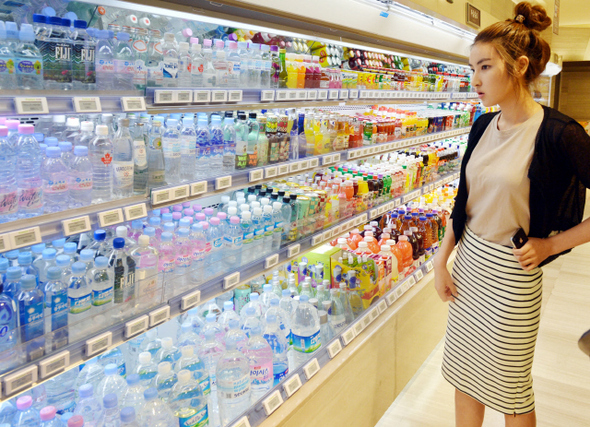The mysteries of bottled water in South Korea
이 글자크기로 변경됩니다.
(예시) 가장 빠른 뉴스가 있고 다양한 정보, 쌍방향 소통이 숨쉬는 다음뉴스를 만나보세요. 다음뉴스는 국내외 주요이슈와 실시간 속보, 문화생활 및 다양한 분야의 뉴스를 입체적으로 전달하고 있습니다.


[한겨레] Nowadays there are many different bottled water brands with different prices, but the same kind of water
By Yoo Shin-jae, staff reporter
These days at big supermarkets, one can see many different brands of bottled water. The shelves are filled up with over 30 different brands of bottled water, including 10 imported brands. There is as much variance in price as there is in brand. Among the cheapest ones are the brands of big supermarkets, such as 'Bongpyeong Spring Water', and 'Blue' from E-mart, which cost 470 won (about 40 cents) per 2 liter bottle. More expensive are Jeju Samdasu, which costs 910 won per 2 liter bottle at big supermarkets. Baeksan Water, produced in China by Nongsim and then imported to Korea, 1,100 won per 2 liter bottle. Evian and Volvic from France respectively cost 1800 won and 2080 won per 1.5 liter bottle.
Do all these different brands of bottled water really all have distinct tastes?
Different brand, but same source
According to Management of Drinking Water Act, water companies require approval from municipal governments in order to operate a new bottled water business. Based on this, the Ministry of Environment (MOE) last year released 'Current Status on Approval for Drinking Water Manufacturers', which said there were 67 drinking water manufacturers with 67 water sources.
Interestingly, there are cases of several different brands of water all coming from one source. The MOE's data shows that three different labels - Leedong Crystal, Lotte Icis, and Pulmuwon Spring Water - are all drawn from one water source in Pocheon, Gyeonggi Province. Another water source in Cheongwon, North Chungcheong Province supplies more than four brands including Lotte 'Icis', Homeplus 'Clear Water', Kim's Club 'Spring Water', Choice L 'Spring Water'.
Also, it was not difficult to find one mineral water label coming from multiple sources. For example, Lotte Icis is drawn from 6 different sources in South Korea, and Hite Jinro's 'Natural Mineral Water' and 'Puris' are sourced from 7 and 8 sources respectively. Pulmuwon's 'Spring Water' and Dongwon's 'MineMine' are drawn from 5 sources.
This means that the quality of water sold throughout the country can't be guaranteed as having been drawn from only one source. This also means that water sold by different brands could actually have come from the same source. The only exceptions are 'Jeju Samdasu', and 'Deep Sea Water 1000K'. 'Jeju Samdasu' is drawn from only one source in Jocheon, Jeju Island, and 'Deep Sea Water 1000K', is drawn solely from the East Sea off Goseong, Gangwon Province.
How is the price determined?
Pulmuwon's Deep Water costs 860 won for 2 liters, Nestle's Purelife 740 won, Costco's Kirtland Signature 650 won, come from the same source. This illustrates the controversy: price of mineral water does not reflect the actual quality of the water.
The distorted pricing problem was also found in a mineral quantity analysis experiment of different brands. Last August, Consumers Korea requested Water quality & Food Analysis Unit at KOTITI Testing & Research Institute to analyze the amounts of calcium, sodium, potassium, and magnesium in 15 different mineral water brands. The conclusion of the experiment was that 'high price does not guarantee the high mineral contents'.
Another experiment was conducted in 2009 by an institution well known for water quality analysis. It analyzed the contents of 8 minerals in 22 domestic and imported mineral water brands, but in the end could not find any correlation between mineral content and price. Such experiments may provide no insight in a situation where each brand's water may come from multiple sources.
How is the price of mineral water actually determined? Mineral water typically requires large capital investment only in the initial stage. After the installation of water pipes at the source, production costs are minimal.
Bottled water brands all must pay the same taxes. Provincial governments charge both domestic and imported mineral water brands 2200 won for every 1-ton of water (approximately 4.4 won for every 2 liters). It then costs 2 won for the manufacturers to produce a lid that comes with a special sign that proves the tax has been paid. In addition, the plastic bottle costs 70 to 80 won. In total, input cost for a 2 liter bottle of water adds up to less 100 won. This means the retail price is much higher than the actual cost of production due to a combination of distribution cost and high profit margin for the retailers. This is why the big supermarkets can undercut bottled water brands and offer their own cheaper options.
Brand image also plays a significant role in price setting. 'it Water' is premium mineral water whose bottle is designed by Hyundai Card, but sold and distributed by E-mart. This high-end mineral water costs 900 won for 350ml, which is 20% more expensive than E-mart's own PB water (Boons Water), although they are actually drawn from the same source. 'it Water' takes advantage of its packaging and luxurious image to charge a higher price. Along the same lines, the trend of increased consumption of imported premium mineral water, despite it being 10 times more expensive than domestic mineral water brands, could be justified.
Please direct questions or comments to [english@hani.co.kr]

공식 SNS [통하니][트위터][미투데이]| 구독신청 [한겨레신문][한겨레21]
Copyrights ⓒ 한겨레신문사, 무단전재 및 재배포 금지
<한겨레는 한국온라인신문협회(www.kona.or.kr)의 디지털뉴스이용규칙에 따른 저작권을 행사합니다.>
Copyright © 한겨레. All rights reserved. 무단 전재, 재배포 및 크롤링 금지.